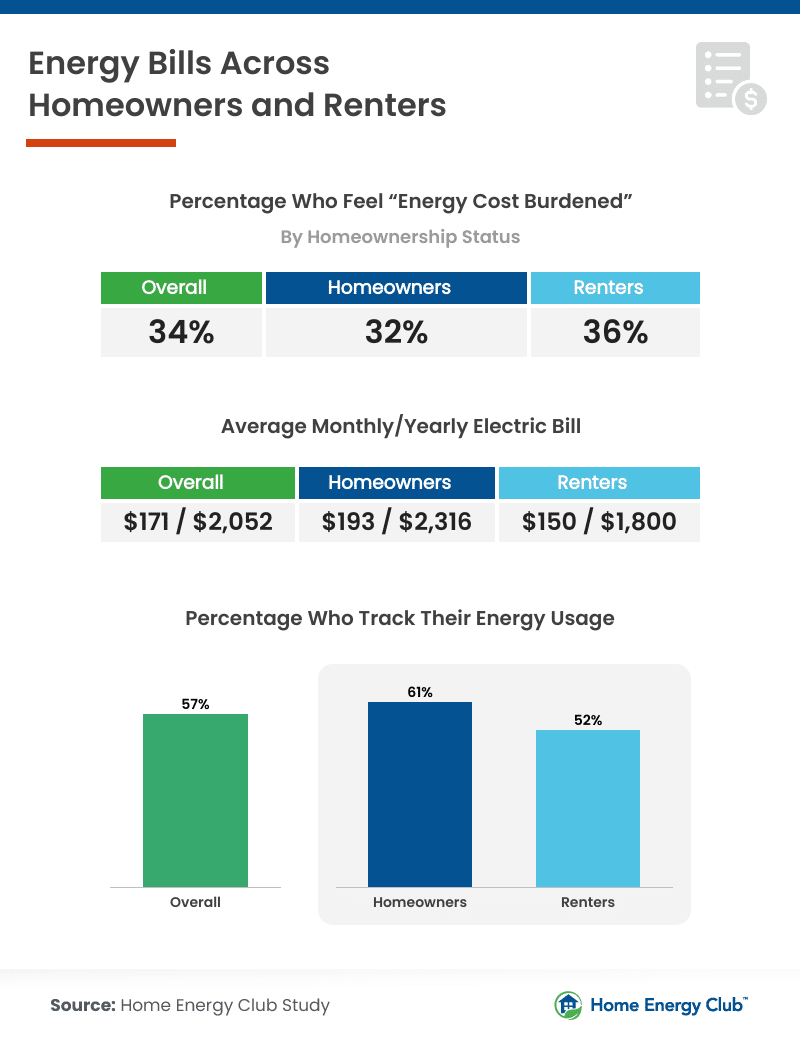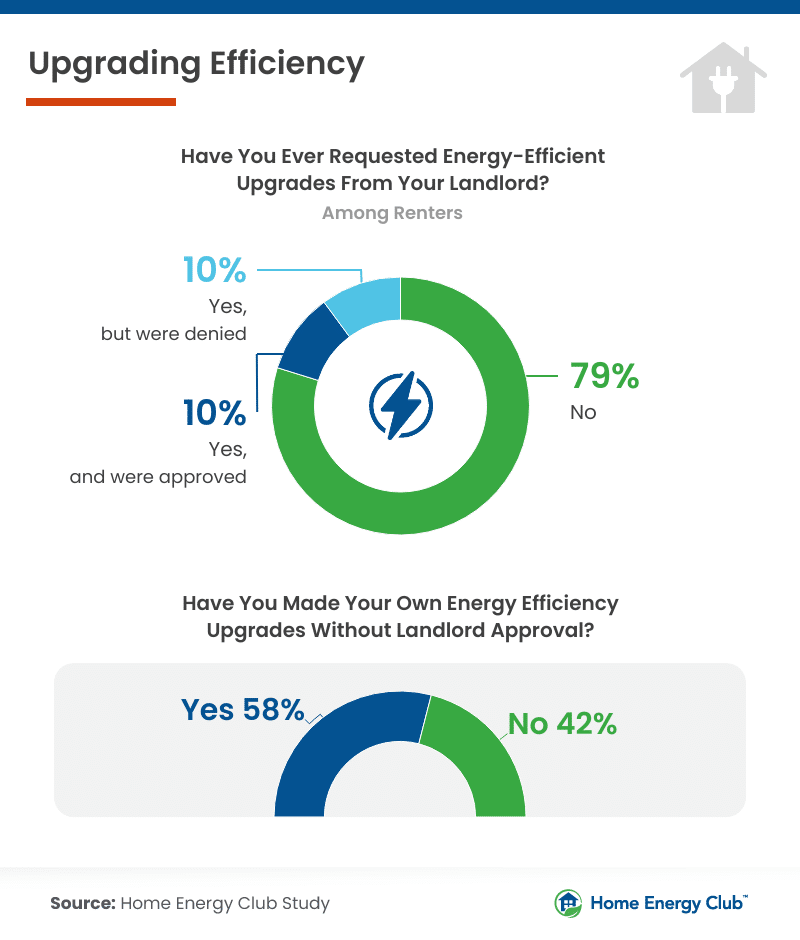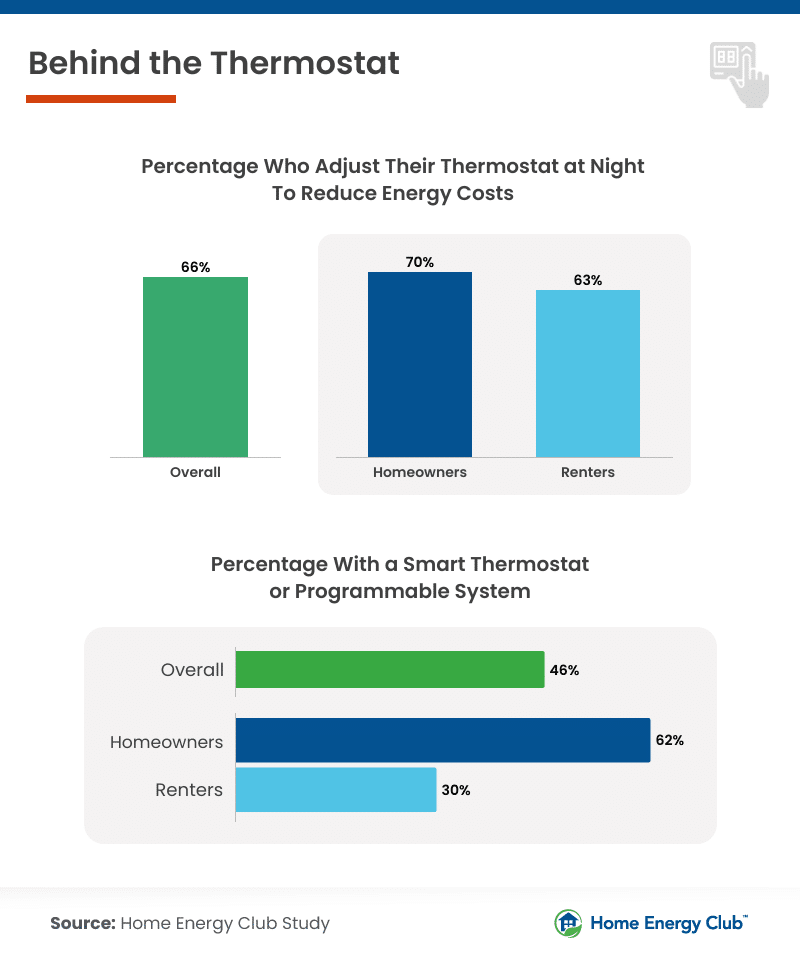
Energy and electricity costs impact homeowners and renters differently, from their monthly bills to their ability to make energy-efficient improvements. Our survey of 1,008 Americans — 51% homeowners and 49% renters — examined how these groups handle energy expenses and more. The results reveal clear differences in financial strain, electricity use and access to efficiency upgrades.
Key Takeaways
- 34% of Americans feel burdened by energy costs. Renters (36%) are more likely than homeowners (32%) to report this.
- 1 in 6 Americans have missed an energy payment due to high costs. Renters (20%) were nearly 2x as likely as homeowners (12%) to have done so.
- 38% of Americans say energy bills limit saving for essentials, with renters (42%) being more affected than homeowners (35%).
- 58% of renters took energy efficiency into their own hands, making energy-efficient upgrades without landlord approval.
- 38% of Gen Z renters would pay higher rent for guaranteed energy-efficient upgrades.
- 66% of Americans adjust their thermostat at night to save energy. Homeowners (70%) are more likely than renters (63%) to adopt this cost-saving habit.
Energy Cost Burdens in American Households
Households spending 6% or more of their income on energy costs are considered a high energy burden household. More than one-third of Americans (34%) reported being burdened by energy costs, with renters (36%) facing slightly higher pressure than homeowners (32%).
The weight of high energy expenses affects Americans’ financial stability, with 38% saying that energy bills limit their ability to save for essentials like groceries, healthcare, and emergency funds. Renters were more affected (42%) than homeowners (35%) in this regard.

https://infogram.com/a1-1h984wvpxer1z2p?live
Energy burdens have also forced some into difficult decisions — 1 in 6 Americans missed an energy payment in the past year due to high costs. Renters (20%) were nearly twice as likely as homeowners (12%) to fall behind. Younger generations were particularly vulnerable, as 15% of both Gen Z and millennials reported missing a payment.
Seasonal spikes in energy costs exacerbate the strain. Nearly half of renters (46%) felt unprepared for these fluctuations, compared to 35% of homeowners. Overall, 41% of Americans believed they would struggle to manage costs during these periods of higher energy use.
Landlords, DIY, and Energy Efficiency Gaps
Energy efficiency has become a priority for many renters and homeowners, but the approach differs between the two groups.
About 20% of renters have formally requested energy-efficient upgrades from their landlords, and half of them had their requests denied. Nearly 3 in 5 renters said they had bypassed approval and made the upgrades themselves. Homeowners have taken a more proactive role, with almost 3 in 4 implementing energy-efficient improvements in their homes.

https://infogram.com/a2-1hmr6g8kypqvz2n?live
Younger renters, particularly Gen Zers (54%), have been the most cautious about making independent improvements. For others, the prospect of energy-efficient living is worth the cost — 32% of renters were willing to pay higher rent for guaranteed upgrades, with Gen Z renters (38%) being the most willing to make this tradeoff.
Among homeowners, most have embraced energy efficiency, but the level of commitment varies. While 74% have made some improvements, 15% of homeowners have yet to make any upgrades. Only 11% have fully upgraded their homes, with Gen Z homeowners leading at 16%.
The Role of Smart Thermostats in Reducing Energy Costs
Temperature control represents one of the most direct ways Americans cut their energy bills. While both homeowners and renters adjust their thermostats to save money, their preferred settings and access to smart technology show clear differences.

https://infogram.com/a3-1hxj48m1n5o8q2v?live
Two-thirds of Americans said they adjust their thermostats at night to reduce energy usage, with homeowners (70%) being more likely than renters (63%) to adopt this habit.
On average, adjusting the thermostat saved households $31 per month, with homeowners ($33) reporting higher savings than renters ($28). Preferred temperatures varied slightly — homeowners kept their homes at 71°F during summer and 68°F in winter, while renters opted for 70°F and 69°F, respectively.
Most Americans (87%) considered energy-efficient upgrades like smart thermostats and insulation critical for lowering costs and improving comfort, with homeowners (89%) placing slightly more importance on these improvements than renters (86%).
Interestingly, 42% of Americans admitted feeling guilty when raising their thermostat during extreme weather. Homeowners (44%) were more prone to this guilt than renters (39%). Due to recent cold spells, 1 in 8 Americans delayed or skipped a utility payment. Renters (15%) were more likely to fall behind compared to homeowners (11%).
A Homeowner-Renter Comparison
Rising electricity costs affect every household, but financial strain falls harder on renters, who have fewer options for making improvements. While renters often turn to DIY solutions, homeowners can invest in permanent upgrades and tend to adopt more daily energy-saving habits. This difference in control over living spaces continues to shape how Americans manage their energy costs.
Methodology
We surveyed 1,008 Americans to explore how energy costs and behaviors differ between renters and homeowners across the United States. Among them, 51% were homeowners and 49% were renters. The generational breakdown of respondents was as follows: Gen Z (13%), millennials (54%), Gen X (24%), and baby boomers (9%). Survey data was collected on January 27, 2025. Some percentages throughout may not total exactly 100 due to rounding.
About Home Energy Club
Home Energy Club helps consumers find the best electricity rates while promoting energy-efficient living. By offering unbiased provider reviews and tools for comparing plans, the platform empowers homeowners and renters to reduce costs and avoid hidden fees. With a focus on transparency and savings, Home Energy Club simplifies the process of making smarter energy decisions.
Fair Use Statement
Noncommercial sharing of these insights is permitted if proper credit is given via a link.


